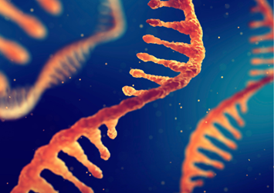RNA Extraction / Purification Reagents
RNA plays a critical role in the expression of genetic information. As RNA is remarkably less stable than DNA, obtaining RNA with high quality in the extraction and purification process is important in RNA-related experiments. Fujifilm Wako provides RNA extraction and purification reagents that can purify high-quality RNA.
Product Line-up
More Information
Basic Procedures for RNA Extraction and Purification, and Their Principles

RNA extraction and purification are essential processes in gene expression analysis and cDNA Cloning. As a ribose, a component of RNA, has a hydroxyl group at the 2'-position, RNA is highly reactive and is more susceptible to degradation than DNA; therefore, RNA should be handled with caution. In addition, RNA degradation enzyme (RNase), which is present in living organisms, easily degrades RNA and is unlikely to be inactivated by heat, and it is difficult to inhibit its activity by chelating agents because it does not require cation for its activity. Thus, an important point in RNA extraction and purification is how quickly RNase can be inactivated.
Procedures for the acid guanidium-phenol-chloroform (AGPC) method, a typical RNA extraction and purification method, and their principles are described below. The AGPC method has been improved, and at present, dissolution buffer containing guanidine isothiocyanate and phenol, as described later, is widely used as an RNA extraction reagent (e.g., ISOGEN from NIPPON GENE). The improved method can be applied to a wide range of samples and has the advantage of enabling recovery of DNA and protein from the same sample.
Cell Lysis and Protein Denaturation
The first step of RNA extraction is cell lysis. Cells are lysed or homogenized in lysis buffer consisting of guanidine isothiocyanate (denaturant), sarkosyl (surfactant), mercaptoethanol (reducing agent), and sodium citrate (pH 7.0). As described above, how quickly RNase can be inactivated is important in RNA extraction and purification, and guanidine isothiocyanate, with stronger protein denaturation action than other guanidine salts is used. Guanidine isothiocyanate can denature all proteins in the sample, including RNase.
Impurity Removal
To make the condition acidic, sodium acetate of pH 4.0 is added to the sample. Phenol/chloroform is added, and the resulting solution is centrifuged. RNA is then separated into an aqueous phase, and protein and DNA is separated into a phenol phase. RNA can be separated by collecting the aqueous phase.
Washing and Dissolution/Elution
RNA in the aqueous phase is precipitated and washed with isopropanol and ethanol. RNase-free water or diethylpyrocarbonate (DEPC)-treated water is used to dissolve RNA.
In addition to the above-mentioned AGPC method, there is another method to extract and purify RNA, using a spin column containing a silica membrane (ISOSPIN RNA series from NIPPON GENE). This method can process more samples compared with the AGPC method, and has advantages including a high yield and that no organic solvent is required. The AGPC method is effective for samples with high RNase activity or high lipid content.
References
Green, R. M. and Sambrook, J.: ”Molecular Cloning A Laboratory Manual, 4th ed.”, Cold Spring Harbor Laboratory Press (2012).
For research use or further manufacturing use only. Not for use in diagnostic procedures.
Product content may differ from the actual image due to minor specification changes etc.
If the revision of product standards and packaging standards has been made, there is a case where the actual product specifications and images are different.
The prices are list prices in Japan.Please contact your local distributor for your retail price in your region.



